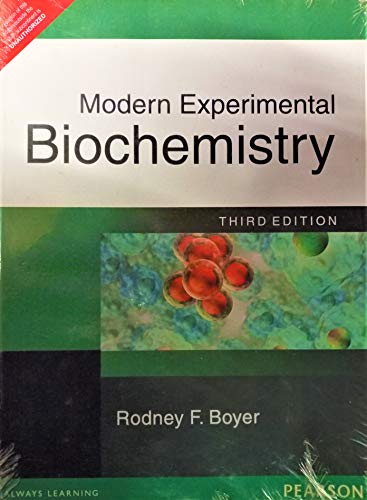
Concepts Biochemistry Rodney Boyer Pdf Free
Synopsis • Intended for the one-semester, sophomore/junior level course, Boyer's text is written for a range of majors including Chemistry, Biology, Food Science, Agriculture, Pharmacy, and Environmental Studies. It is also appropriate for use in one-term Biochemistry courses now required for certification by the American Chemical Society. Prerequisites for the course include General and Organic Chemistry.
Boyer enhances the understanding of biological processes by initiating the study of Biochemistry with nucleic acids, especially DNA, playing a more central role. Other biomolecules are treated as direct or indirect products.
Modern experimental biochemistry / Rodney Boyer. All triglycerides completely in to glycerol and free fatty acids as soap [12, 13]. Concepts in the BMB lab. Download Concepts In Biochemistry ebook PDF or Read Online books in PDF, EPUB. Jargon-free language and award-winning teaching techniques including algorithms, mnemonics and clinical examples. Rodney Boyer's text gives students a modern view of biochemistry. He utilizes a contemporary approach organized around the theme of nucleic acids.
 The Passat is designed to help out and be family-friendly, thanks to a standard Blind Spot Monitor 12 and available VW Car-Net that lets you connect with your car. Blind Spot Monitor When driving, if you attempt to change lanes, the Blind Spot Monitor can help alert you to cars that may be in your blind spot. 2016 Volkswagen Passat Reveal Debuting at the 2019 North American International Auto Show in Detroit, the 2020 Volkswagen Passat features new styling, new tech and added safety.
The Passat is designed to help out and be family-friendly, thanks to a standard Blind Spot Monitor 12 and available VW Car-Net that lets you connect with your car. Blind Spot Monitor When driving, if you attempt to change lanes, the Blind Spot Monitor can help alert you to cars that may be in your blind spot. 2016 Volkswagen Passat Reveal Debuting at the 2019 North American International Auto Show in Detroit, the 2020 Volkswagen Passat features new styling, new tech and added safety.
It is an approach that captures the student's attention by giving them a current and practical sense of Biochemistry and presenting applications that can be used in their careers. This focus makes the text particularly relevant for students in allied health, agriculture, and related programs. An accompanying interactive CD ROM/Web site provides additional opportunity for study and enrichment. It contains Animations, Concept Reviews, Cutting Edge Biochemistry Materials, and Structural Tutorials. • Intended for the one-semester, sophomore/junior level course, Boyer2s text is written for a range of majors including Chemistry, Biology, Food Science, Agriculture, Pharmacy, and Environmental Studies. It is also appropriate for use in one-term Biochemistry courses now required for certification by the American Chemical Society.
Download anime inazuma eleven sub indo full episode 3. Prerequisites for the course include General and Organic Chemistry. Boyer enhances the understanding of biological processes by initiating the study of Biochemistry with nucleic acids, especially DNA, playing a more central role. Other biomolecules are treated as direct or indirect products.
It is an approach that captures the student2s attention by giving them a current and practical sense of Biochemistry and presenting applications that can be used in their careers. This focus makes the text particularly relevant for students in allied health, agriculture, and related programs. An accompanying interactive CD ROM/Web site provides additional opportunity for study and enrichment. It contains Animations, Concept Reviews, Cutting Edge Biochemistry Materials, and Structural Tutorials. Table Of Content • 1.
Biochemistry: Setting the Stage. The Flow of Biological Information. Biomolecules in Water. Amino Acids, Peptides, & Proteins. Protein Architecture & Biological Function.
Enzymes I: Reactions, Kinetics, Inhibition, Application. Enzymes II: Coenzymes, Regulation, Catalytic Antibodies, & Ribozymes. Carbohydrates: Structure & Biological Function.
Lipids, Biological Membranes, and Cellular Transport. DNA and RNA: Structure and Function. DNA Replication and Transcription. Translation if RNA. Recombinant DNA and Other Topics in Biotechnology. Basic Concepts of Cellular Metabolism in Bioenergetics. Metabolism of Carbohydrates.
Production of NADH and NADPH. ATP Formation by Electron-Transport Chain. Metabolism of Fatty Acids and Lipids.
Metabolism of Amino Acids and Other Nitrogenous Compounds. Integration, Coordination, and Specialization in Metabolism.
1 The abbreviations used are: BMB, Biochemistry/Molecular Biology; MS, mass spectrometry; ASBMB, American Society for Biochemistry and Molecular Biology; HPLC, high pressure liquid chromatography. Teaching laboratory has become a prominent and essential fixture in the training of undergraduate students for careers related to the molecular life sciences (biochemistry, molecular biology, chemistry, genetics, immunology, microbiology, neurochemistry, etc.). These students must acquire extensive experience working with biomolecules in the laboratory, and a formal lab course is usually the best first step to that experience.

This step provides students the skills needed for future research participation at the undergraduate and graduate level and for jobs in the biotechnological and pharmaceutical industries. In addition, a lab experience is also an asset for those science majors preparing for careers in law and business that may be related but outside the realm of the basic sciences (patent law, pharmaceutical sales, etc.).
With the acknowledged importance of a lab experience for all students, it is surprising that there is such a sparsity of literature references with discussion on the elements that make up an effective BMB laboratory experience. For example, what technical skills and procedures must be practiced and mastered by students? What teaching modes work best to most effectively train students in the lab? What instrumentation should undergraduate students become familiar with? What is the importance of the “other lab skills” such as communication (written and oral), teamwork, ethics, fairness, and responsibility? In this discussion I will not be able to provide completely satisfying answers to all these questions, but hopefully I will be able to provide insight and food for future thought. BMB LABS OF THE PAST AND PRESENT The standard approach to teaching the BMB lab, for many years, has been to: • select appropriate experiments from a textbook adopted for the class (Refs.